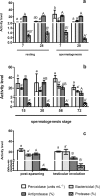Endocrine disrupter chemicals affect the humoral antimicrobial activities of gilthead seabream males even upon the cease of the exposure
- PMID: 32409650
- PMCID: PMC7224181
- DOI: 10.1038/s41598-020-64522-2
Endocrine disrupter chemicals affect the humoral antimicrobial activities of gilthead seabream males even upon the cease of the exposure
Abstract
17α-ethynilestradiol (EE2) and tamoxifen (Tmx) are pollutants world-wide distributed in aquatic environments. Gilthead seabream, Sparus aurata L., is highlighted as a species model of intensively culture in anthropogenic disturbed environments. The effects of these pollutants on gilthead seabream reproduction and some immune responses have been described but, the humoral innate antimicrobial activities have never received attention. In this work we analysed the latest in the plasma of gilthead seabream males of different ages and reproductive stages treated with 0, 2.5, 5 or 50 μg EE2 or 100 μg Tmx g-1 food during different times of exposure and of reverting to commercial diet (recovery). The peroxidase and protease activities decreased as the spermatogenesis of the first reproductive cycle (RC) proceeded in control fish. However, only protease and antiprotease activities showed different level at different stages of the second RC in control fish, but showed scarce disruption in fish treated with EE2 or Tmx. Peroxidase and bactericide activities are more sensitive to EE2, than to Tmx. The effects induced by EE2 varied depending on the activity analyzed, the dose and the time of exposure and the reproductive stage and the age of the specimens.
Conflict of interest statement
The authors declare no competing interests.
Figures





Similar articles
-
Tamoxifen persistently disrupts the humoral adaptive immune response of gilthead seabream (Sparus aurata L.).Dev Comp Immunol. 2015 Dec;53(2):283-92. doi: 10.1016/j.dci.2015.06.014. Epub 2015 Jul 30. Dev Comp Immunol. 2015. PMID: 26234710
-
Tamoxifen disrupts the reproductive process in gilthead seabream males and modulates the effects promoted by 17α-ethynylestradiol.Comp Biochem Physiol C Toxicol Pharmacol. 2016 Jan;179:94-106. doi: 10.1016/j.cbpc.2015.09.005. Epub 2015 Sep 25. Comp Biochem Physiol C Toxicol Pharmacol. 2016. PMID: 26404755
-
17α-ethynylestradiol prevents the natural male-to-female sex change in gilthead seabream (Sparus aurata L.).Sci Rep. 2020 Nov 18;10(1):20067. doi: 10.1038/s41598-020-76902-9. Sci Rep. 2020. PMID: 33208754 Free PMC article.
-
17α-Ethynylestradiol alters the peritoneal immune response of gilthead seabream.Dev Comp Immunol. 2017 Nov;76:143-149. doi: 10.1016/j.dci.2017.06.002. Epub 2017 Jun 10. Dev Comp Immunol. 2017. PMID: 28595972
-
Effects of dihydroquercetin obtained from deodar (Cedrus deodara) on immune status of gilthead seabream (Sparus aurata L.).Fish Shellfish Immunol. 2015 Mar;43(1):43-50. doi: 10.1016/j.fsi.2014.12.009. Epub 2014 Dec 19. Fish Shellfish Immunol. 2015. PMID: 25530582
Cited by
-
Priming European Sea Bass Female Broodstock Improves the Antimicrobial Immunity of Their Offspring.Animals (Basel). 2023 Jan 26;13(3):415. doi: 10.3390/ani13030415. Animals (Basel). 2023. PMID: 36766303 Free PMC article.
-
Modulation of immune gene expression profile in Labeo catla with chronic toxicity to emerging endocrine disruptors through a multiorgan approach.Sci Rep. 2025 Apr 2;15(1):11244. doi: 10.1038/s41598-025-95996-7. Sci Rep. 2025. PMID: 40175507 Free PMC article.
-
Vaccination of Gilthead Seabream After Continuous Xenoestrogen Oral Exposure Enhances the Gut Endobolome and Immune Status via GPER1.Front Immunol. 2021 Oct 14;12:742827. doi: 10.3389/fimmu.2021.742827. eCollection 2021. Front Immunol. 2021. PMID: 34721409 Free PMC article.
References
Publication types
MeSH terms
Substances
LinkOut - more resources
Full Text Sources

